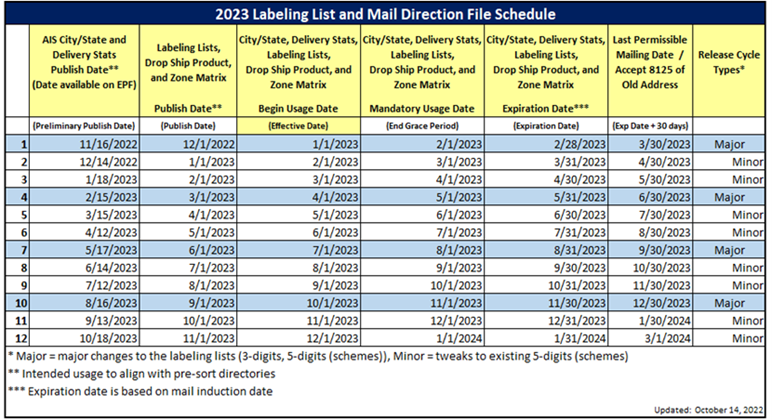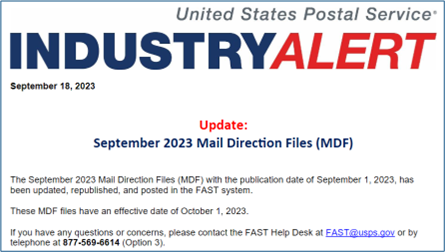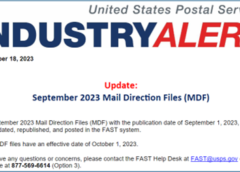The following article was provided by Deborah Damore, Director, Postal Affairs, Enru Logistics & Postal Optimization. Enru is a Mailers Hub Cornerstone Sponsor.

There are multiple facets to the Postmaster General’s 10-Year Plan, each having an impact on costs, revenue, employees, and USPS customers.
The part of the plan causing some angst this month is resulting from Network Transformation. The Postal Service is moving forward with the modernization of its network, which is affecting how we prepare, and where we inject mail. In order to make these changes there are several things that need to happen, often, it seems behind the curtain.
As the USPS integrates its mail and packaging processing network, it requires the movement of equipment and processes from a current location to a new location. This movement could have an impact by class, by shape, and by destination. To achieve the desired results of specific ZIP Codes being prepared in a specific container and entered at a specific facility, the instructions need to be communicated through USPS files supplied to and utilized by software vendors who, in turn, include this information in the products industry uses to prepare and enter mail. The USPS files include:
- Labeling Lists – Labeling Lists assist mailers with presorting mail. They provide active, originating 3- and 5-digit ZIP Code data, along with their destination locations. There are currently 21 Labeling Lists, such as L601, L010, L605, etc.
- Mail Direction File (MDF) – The MDF generates default drop entry point AND redirection data that can be used to determine delivery location based on several different data elements including mail characteristics, class, discount level, and destination ZIP Codes.
Some mailers may not know that the Labeling Lists and MDF are managed by two different departments within the USPS. Though both are critical to proper mail preparation and entry, the Labeling Lists are managed by the Enhanced Electronic Label List System group in Saint Louis, while the MDF is managed by the FAST team at USPS HQ in Washington. The EELLS group generates the Labeling Lists and sends the FAST team a ZIP/CRID file monthly that then is used by FAST to create and publish the MDF.
The Postal Services provides a predictable schedule for file changes with a 90-day cadence, happening on the first of each month. For an example, using September 1 as day one:
- Day 1, September 1, 2023 – Publish Date – this is the date that the USPS publishes the Labeling Lists and Mail Direction Files that may be used starting the first of the next month. This is published with an “advertisement date” in order to allow people to begin presorts for production of jobs that mail at a future date.
- Day 30, October 1,2023 – Effective Date – this is the first date that mail can be paid for or entered when presorted into containers, (trays, bundles, sacks, pallets) using the file with the 9/1 publish date, following the directions of Labeling Lists and entry instructions in the MDF.
- Day 60, November 1, 2023 – Mandatory Usage Date – if using the data from the 9/1 file to prepare mail, all of that mail MUST be using that file’s containerization and entry instructions.
- Day 90, November 30, 2023 – Expiration Date – As of this date, the files with the 9/1 publish date may no longer be used for containerization or entry.
There is always a thirty-day overlap during which mailers have a choice of two different file sets to use.
Below is the 2023 schedule showing that the USPS updates the 5-digit Labeling Lists monthly while the 3-digit files update only on a quarterly basis (“Major”). Beginning in October, the USPS is moving to monthly updates for both the 5-digit and 3-digit files, effectively doing a “Major” release each month. The increased frequency of change is necessary to align mail preparation and entry with USPS processing changes that are occurring more frequently as Network Transformation continues.

This month, we experienced a delay of 18 days in receiving a workable MDF. The delay impacted mailers who were planning to start production of jobs with November mail dates as they would be required to use the September-publish files. New to the October 1 L601 Labeling List is the inclusion of the first Regional Processing and Distribution Center in Richmond (VA) (Richmond 230). Fifteen 3-digit ZIP Codes were moved from the Washington NDC and Greensboro NDC to define the make-up for the new Richmond RPDC pallet.
(Moved from the Washington NDC were 3-digit ZIP Codes 224, 225, 229-239, and 244, while 3-digit ZIP Code 279 was moved from the Greensboro NDC.) The delay in receiving a workable MDF in turn delayed the optimization and entry updates to files for entry in October for pallets created using October 1 L601 sorts for the Richmond RPDC. (The MDF was missing records for the 15 associated 3-digit ZIP Codes at DNDC entry so, if optimizing entry, those pallets would all have gone as origin entry.)
We have a new workable MDF file now, but this challenge highlighted the criticality of USPS organizations working across functional silos, with each better understanding the larger processes and impacts from the other’s work output on what mailers prepare and the USPS processes. We know to expect some hiccups with new roll-outs; our hope is that this will go down as a learning experience with all better documenting the hand-offs and steps necessary to make a successful mail movement.



